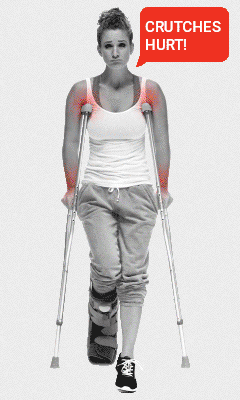Lower Leg Injury Resource Center
Metatarsal Fracture
Symptoms, Causes, Treatments, Surgery and Recovery
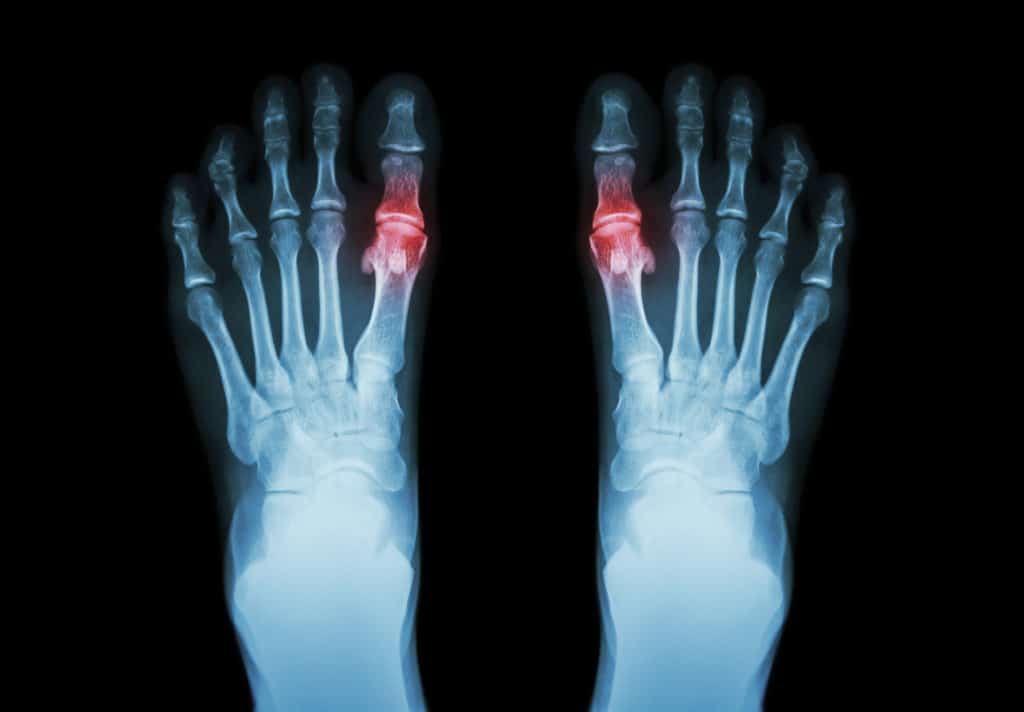
A metatarsal fracture is a break or crack in one of the five long metatarsal bones in the middle of your foot. It’s one of the most common foot injuries and can be caused by either a sudden injury or repeated stress over time. Fractures of the metatarsal bones account for 35 percent of all foot fractures [1].
In most cases, surgery isn’t necessary and treatment involves wearing a cast, walking boot or special shoe, and also resting the injury. If left untreated, metatarsal fractures can become more severe and may cause long-term problems, so it’s important to get your injury properly diagnosed. This article explains more about metatarsal fracture causes, symptoms, treatment options and recovery time.
I
WHAT IS METATARSAL FRACTURE?
The metatarsal bone is the long bone that runs the length of your foot, from the ankle to the toes. There are five metatarsal bones in each foot and when one breaks or cracks, it’s called a metatarsal fracture. Any of the five bones can break but the fifth metatarsal, which runs along the outer part of your foot and connects to your little toe, is most susceptible in adults. It accounts for 68 percent of all metatarsal fractures [2]. When the fracture occurs at the base of the fifth metatarsal, it’s known as Jones fracture. In children the most commonly fractured metatarsal is the first one, which connects to your big toe.
Each metatarsal bone has a big job. They help carry the body’s weight and adjust positions to cope with uneven ground. This also makes them somewhat prone to injury.
Metatarsal bone fracture types
There are two types of metatarsal bone fractures.
- An acute metatarsal fracture is caused by a sudden injury.
- A stress fracture forms slowly over time.
Both types of metatarsal bone fracture are common, especially among athletes who do a lot of running and jumping. It’s so common among top soccer players, in fact, that it’s been dubbed the “metatarsal curse” by professional sports writers.
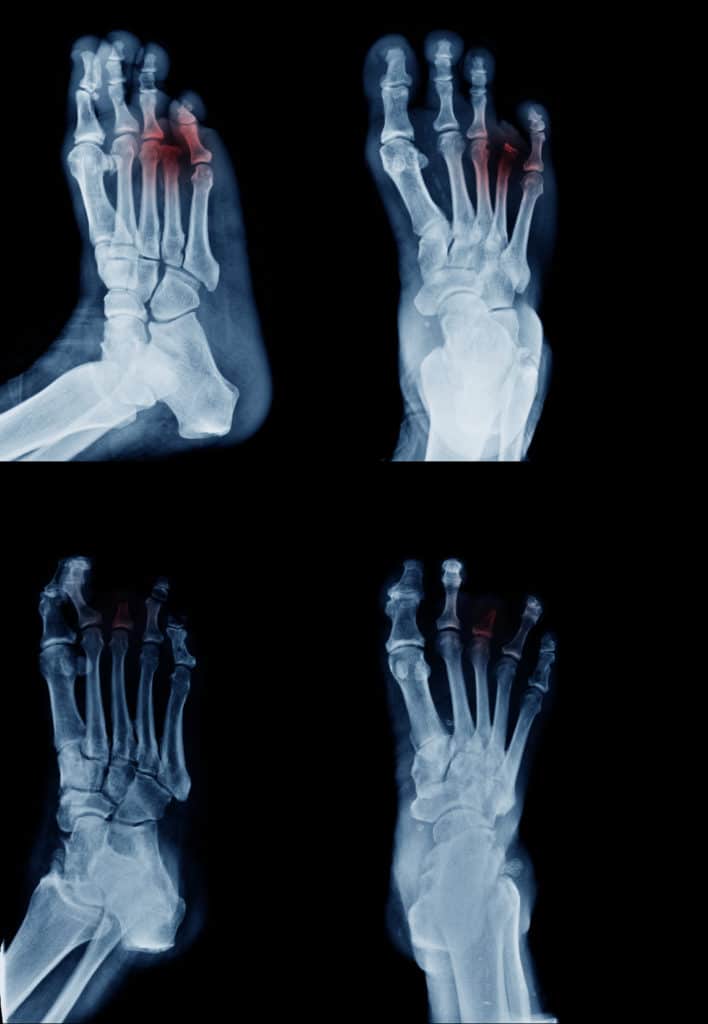
I
COMMON CAUSES OF A METATARSAL FRACTURE
The main causes of a metatarsal fracture are:
- Direct blow to the foot. This is a traumatic injury that happens when a heavy object falls on the foot or a person or animal (like a horse) steps on it. It can also result from kicking a solid object.
- Ankle twisting. When your ankle twists it pulls on the ligament that attaches to the base of your fifth metatarsal. This can result in an avulsion fracture, which is when the tendon pulls away some of the bone.
- Overuse. Activities like running and jumping can put repetitive stress on your metatarsal bones and can cause them to crack over time.
Read more about stress fractures.
Metatarsal fractures are more common among younger people because they’re more likely to engage in sports and activities that can fracture the metatarsal bones. They also occur, however, in older people, particularly when bones are weakened by conditions like osteoporosis.
I
METATARSAL FRACTURE SYMPTOMS
Metatarsal fracture symptoms vary somewhat and depend on whether it’s an acute or stress fracture.
Acute metatarsal bone fracture
In an acute metatarsal bone fracture you may hear an audible crack and feel immediate pain at the location of the injury. You may develop bruising and swelling and have trouble putting weight on your foot. Some people find they can’t walk at all. Others can tolerate some weight. Your experience will depend on the location and severity of the break.
Metatarsal bone stress fracture
With a metatarsal bone stress fracture, symptoms are unlikely to form suddenly. You may start to notice pain when exercising, but symptoms often fade when you stop. If left untreated, the pain will gradually worsen and become more persistent. You may notice swelling. Eventually the metatarsal stress fracture may develop into a complete metatarsal bone break.
If you suspect a metatarsal fracture visit a doctor. A fracture left untreated can worsen and potentially cause long-term complications. The doctor will examine your foot and if they suspect a metatarsal fracture, will most likely order X-rays. Sometimes your doctor will suggest a more sensitive imaging test like an MRI or CT scan. This is because small stress fractures aren’t always visible in X-rays.
I
TREATMENT FOR A METATARSAL FRACTURE
While you’re waiting to see a doctor, try to rest as much as possible and elevate your foot above your hips. Apply an ice pack wrapped in a towel for up to 15 minutes every few hours. Make sure the ice doesn’t make direct contact with your skin to avoid ice burn and don’t apply it for more than 15 minutes. Over-the-counter painkillers like nonsteroidal anti-inflammatory drugs (NSAIDS) can help you manage pain.
Treatment for a metatarsal fracture can vary and depends on the type, location and severity of your injury.
Metatarsal Fracture Non-Surgical Treatment
Most metatarsal fractures don’t require surgery but you’ll need to follow your doctor’s treatment plan to ensure you make a full recovery. For mild stress fractures, you may only need to take it easy for a few weeks and avoid activities that cause pain. You may be given an orthopedic boot or specially designed shoe and will probably be able to walk relatively unimpeded.
For more severe fractures you may need a non-weight-bearing period when you can’t weight your foot at all for up to six weeks. This is essential to give the bone a chance to heal, so it’s important to follow your doctor’s guidelines. You may also need to wear a cast or walking boot during this time to protect your healing metatarsal bone, and you’ll need a mobility device like crutches, a knee scooter or a hands-free crutch to help you get around.
Once you receive clearance from your doctor, you’ll be able to gradually add weight to your foot again and, over a few weeks, begin to resume normal activities.
Surgical Treatment
If one of your metatarsal bones is displaced or you’ve fractured several metatarsal bones at once you may need an operation to repair the damage. This usually involves inserting pins, plates and/or screws to hold your bones in place while they heal. This is called internal fixation.
After surgery you’ll wear a cast or walking boot and probably be non-weight bearing for six to eight weeks.
I
WALKING AFTER A METATARSAL FRACTURE
Your doctor will tell you whether it’s okay to walk or not, and it will depend on the type and severity of your injury. If you need a period of non-weight bearing for a few weeks, it’s normal to feel overwhelmed by the prospect of being immobilized.
To help you get around, you’ll need a mobility device. There are a few to choose from, including traditional crutches, knee scooters and hands-free crutches like the iWALK.
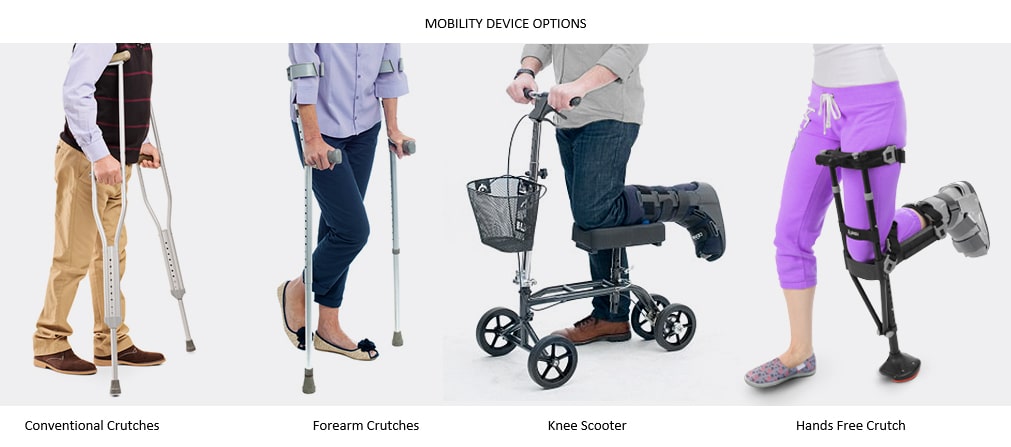
Traditional Crutches
Crutches are the most common type of mobility device and have been around for thousands of years. They are relatively easy to obtain and cheap and are used by millions of people each year. However, they require full attention from your hands, arms and healthy leg and can make simple, everyday tasks impossible. Crutches are also extremely tiring, which can make you reluctant to move around and add to the boredom and frustration of being injured. Crutches can also cause pain in your back, arms and hands. For all these reasons, it is common for people using crutches to cheat during the non-weight bearing phase of recovery, which can result in re-injury and/or a longer recovery periods.
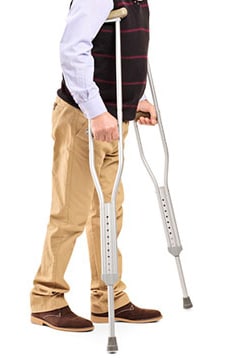
Knee Scooters or Knee Walkers
Knee scooters, also called knee walkers, are a great alternative to crutches. With a handlebar for your hands and a padded platform for your injured leg, the device has four wheels that helps people undergoing recovery to move around without feeling like they’ve run a marathon from the simple exercise of crossing a room. Knee scooters are easy to use, but they have limitations. They can only be used on flat, even surfaces and are not helpful for uneven ground, stairs or slopes. They also require use of your arms and hands for steering, so they don’t make it possible to carry things.
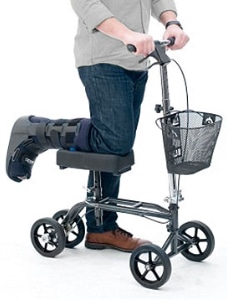
iWALK Hands-Free Crutch
The iWALK hands-free crutch allows people to stay active while recovering from lower leg and foot injuries. It functions like a hi-tech pirate leg and enables you to keep your injured leg elevated and strapped safely to the device while you walk completely unaided and with full use of your hands and arms. This means you can carry on with your everyday life: go to work, push a grocery cart or stroller or go to the gym. Clinical research published by the American Orthpedic Foot and Ankle Society (3) found that nine out of 10 patients prefer the iWALK hands-free crutch to traditional crutches.
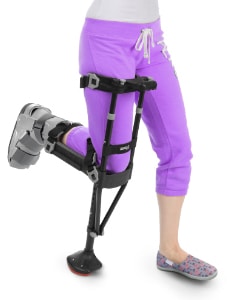
I
RECOVERY
Metatarsal fractures usually take six to eight weeks to heal, but sometimes it can take longer. Recovery will include follow-up X-rays to make sure the bone has healed correctly, and your foot may continue to be swollen for a few months.
Physiotherapy can help improve mobility and prevent long-term problems. You’ll be given some rehabilitation exercises to encourage foot and ankle movement. Your doctor will establish a timeline for you to return to normal activities and sports.
I
METATARSAL FRACTURE FAQS
Metatarsal fractures usually take six to eight weeks to heal, but sometimes it can take longer. Recovery will include follow-up X-rays to make sure the bone has healed correctly, and your foot may continue to be swollen for a few months.
Physiotherapy can help improve mobility and prevent long-term problems. You’ll be given some rehabilitation exercises to encourage foot and ankle movement. Your doctor will establish a timeline for you to return to normal activities and sports.
How long does it take to heal a broken metatarsal?
Healing time for metatarsal fractures is typically six to eight weeks, but in some cases it may take longer. Occasionally it can take a few months. Metatarsal fractures usually heal well, and most people are able to return to their previous level of activity.
What does a fractured metatarsal feel like?
What a fractured metatarsal feels like depends on whether it’s an acute fracture caused by a sudden injury or a stress fracture that develops over time. With an acute fracture you’ll probably feel immediate pain at the location of the injured metatarsal and may even hear an audible crack when it happens. With a stress fracture the pain is usually mild at first. You may only feel it when doing certain activities. Over time, the pain of a stress fracture will probably worsen and become more persistent.
Can you walk on a broken metatarsal?
Depending on the type and severity of your injury, you may be able to walk on a broken metatarsal. Some people find they can’t tolerate any weight at all. Others can still walk, especially if it’s a mild fracture. However, it’s better that you don’t walk until you’ve seen a doctor and know the full extent of the injury. You may need a non-weight bearing period to allow the fracture to heal.
Do metatarsal fractures show up on X-rays?
Most fractures show up on X-rays. However, stress fractures may not be visible when they first develop because they’re too small. If your doctor suspects a stress fracture they may order an MRI or CT scan, imaging tests that are more sensitive.
Can a metatarsal fracture heal on its own?
A metatarsal fracture needs to be evaluated and treated by a medical professional who will prescribe a treatment plan to ensure that it heals correctly. This could include wearing a cast or walking boot and keeping weight off it for a few weeks, or it may include surgery. If left untreated a relatively mild metatarsal fracture could worsen and cause the bone to become displaced, which may then require surgery. Untreated metatarsal fractures also could cause long-term complications, including foot deformity and arthritis.
The information above is intended for informational purposes only and is not intended to prevent, treat, or diagnose any illness or disease. We aim to provide the highest quality information, so if you have any questions on the information above, we welcome your feedback!
I
RESOURCES
- Piyapittayanun, P., Mutthakalin, K., Arirachakaran, A. et al.Comparative outcomes of foot cast and short leg cast in pseudo-Jones avulsion fracture: a single blinded randomized controlled trial. J Foot Ankle Res 12, 47 (2019). https://jfootankleres.biomedcentral.com/articles/10.1186/s13047-019-0359-5
- World J Orthop.2016 Dec 18; 7(12): 793–800. Published online 2016 Dec 18. https://www.ncbi.nlm.nih.gov/pmc/articles/PMC5155254/
- Martin KD, Unangst AM, Huh J, Chisholm J. Patient Preference and Physical Demand for Hands-Free Single Crutch vs Standard Axillary Crutches in Foot and Ankle Patients. Foot Ankle Int. 2019 Oct; 40(10):1203-1208. https://pubmed.ncbi.nlm.nih.gov/31375043/
- https://jfootankleres.biomedcentral.com/articles/10.1186/s13047-019-0359-5
- https://www.ncbi.nlm.nih.gov/pmc/articles/PMC5155254/
- https://www.ncbi.nlm.nih.gov/pubmed/31375043

